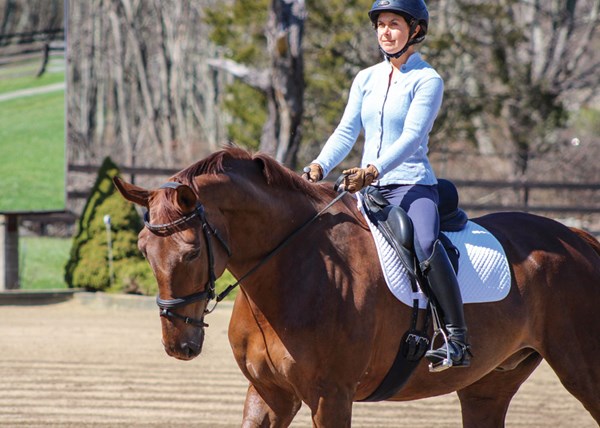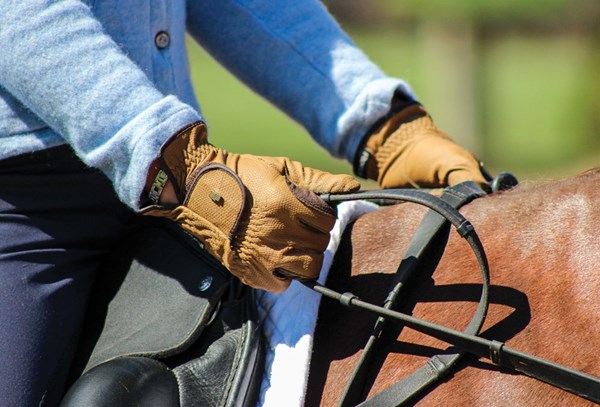Our ultimate goal in dressage at the highest level is to have the horse in self-carriage in collection. However, at every stage of training the horse should be in some degree of self-carriage. That means that the horse maintains his own frame and rhythm to some degree without the rider creating every single stride with her aids. For this to happen, a rider must first be passive with her aids and allow the horse to move on his own. Only then does the rider have the right to change the horse. The rider uses her aids to make the horse better, then she is passive for about two or three strides. She is a part of him, following his movement in harmony. My goal was always that I could do nothing for three strides. If that worked, I was pretty happy.

Every rider that comes to me for a lesson at any level has to prove to me that she can leave the horse alone and be passive with her aids—she has her leg down without pushing the horse and her hands are quiet. It sounds like a simple concept, but I can tell you it isn’t. To ride with an absolutely passive contact, you must have a soft, elastic feel of the horse’s mouth. In other words, if you could put a little scale at the end of the reins throughout the work, most of the time the scale would register the same amount of minimal pressure. Likewise, you can walk, trot and canter with your heels down and your legs hanging quiet. Realistically, when the rider first tries this, the horse may change his tempo or his frame. At this point, to me it doesn’t matter how the horse goes as long as he’s safe. I have taken many an FEI rider and asked her to prove to me she could leave the horse alone and just be part of him. I think for the upper-level rider, it’s harder because she is so used to micromanaging each stride. Let’s not be too idealistic. I’m not saying the horse is a robot that you put in gear and he stays exactly the same until you change gears again. However, on any horse you should be able to do nothing for at least two to three strides.
The Reins and Arms
To ride with a passive contact, you have to have elastic arms. Start at the hands. If you have tight fists holding the reins, the chances of you having elastic arms are slim. Basically, you hold the reins between the thumb and top finger, leaving your other fingers to move the reins as needed. If your fists are tight, that tightness is going to go through your arms. The wrists are mobile and can be used to move the reins. But you’ve got to be able to keep them still for the passive contact. The muscles of the lower arms basically keep gravity from taking over. In other words, the muscles keep the hands up but there is no tension in the arms. Your upper arms and your back have positive muscle tension to stay tall yet soft. The soft fists, quiet wrists and relaxed lower and upper arms have just enough weight to take the slack out of the reins. Ultimately, you can walk, trot, canter and do your transitions with a quiet contact that follows the horse’s mouth with light pressure and you can simply be part of him. Once you can do that, then I think you have the right to ask the horse to change his way of going.


The Legs and Seat
Passive legs allow gravity to pull them down so the knees are low, the heels are down and at any gait you are able to ride without using your legs. The seat and the back can also be passive. You should carry your upper body, allow your seat to sink down in the saddle and have it basically stay there no matter what is going on. Your upper body is the platform off which your aids work and it should be stable yet moving with the horse, not against him. Can your legs stay stretched down and relaxed or do they grip? If the horse gets lazy, then you push him on and use your legs, but afterward they should become silent. For two to three strides, your legs hang down close to the horse’s sides. An example of unconsciously overused legs is a posting trot in which every time the rider sits in the saddle, she accidentally squeezes with her legs.
Practice Passive Aids
At the walk, the horse moves his head up and down. To be part of him, your hands have to move with his head, forward and back. At the trot, the horse’s head is still, but the rider goes up and down. Whether you’re posting or sitting, even if you sit well, there’s a little bounce. If your elbows are rigid, your hands go up and down. The rider lets the elbows open and close so her hands stay in one spot: As you go up, your elbows open a little and as you come down, your elbows close a little. In the canter, the horse rocks up horizontal and then down every stride and the rider rocks to one degree or another forward and back. In a beautifully balanced collected canter there is little motion, but a lower-level horse will rock more. If the rider’s elbows stay fixed and rigid, she catches the horse in the mouth at the end of each stride when he rocks down. To keep a steady contact with the horse’s mouth throughout the canter stride, you need to feel what you did in the walk. The elbows must open and close and the hands move forward and back, which absorbs the rider’s body going forward and back and the rocking motion of the horse.
To teach a rider this correct motion, I ask her to point her pinkies out and just touch them to the saddle pad right in front of the saddle. That helps the hands stay in one spot as the horse and rider move. I like having something that she touches lightly with the pinkies rather than holds tightly with her hands because then the rider may accidentally pull up against it and get the wrong feeling of pulling up and back.
A seat lesson on the longe can be incredibly helpful for developing passive, independent aids. In a longe lesson, the rider is not responsible for how the horse goes and she can just follow the horse with her aids and practice just being there.
I like to see a rider prove that she can be passive and part of the horse for more than two to three strides. When practicing off the longe, the horse has to be helpful. For example, if a rider has a horse who has a tendency to run, he will speed up with the passive aids. In this case, it’s best to put the rider on a lazier horse to practice.
Many riders do not believe they are moving their hands or legs unconsciously. For example, a rider who unintentionally learns to see-saw the reins nonstop, might swear on a stack of bibles that she wasn’t moving them. I suggest riders watch themselves on video. Nowadays, we all have our smartphones with us, so as an instructor I just pick it up, make a quick video and the rider can look at it immediately; she doesn’t have to go back home and watch it on a screen.
To attain the goal of self-carriage, allow the horse to carry himself by riding with completely passive aids. Learn to use the aids and then release them for two to three strides. With practice, passive aids will develop not only a better-trained horse, but also a more elegant and harmonious rider.











